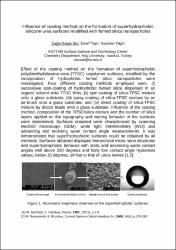Influence of coating method on the formation of superhydrophobic silicone-urea surfaces modified with fumed silica nanoparticles
Özet
Effect of the coating method on the formation of superhydrophobic polydimethylsiloxane-urea (TPSC) copolymer surfaces, modified by the incorporation of hydrophobic fumed silica nanoparticles were investigated. Four different coating methods employed were: (i) successive spin-coating of hydrophobic fumed silica dispersed in an organic solvent onto TPSC films, (ii) spin-coating of silica-TPSC mixture onto a glass substrate, (iii) spray coating of silica-TPSC mixture by an air-brush onto a glass substrate, and (iv) direct coating of silica-TPSC mixture by doctor blade onto a glass substrate. Influence of the coating method, composition of the TPSC/silica mixture and the number of silica layers applied on the topography and wetting behavior of the surfaces were determined. Surfaces obtained were characterized by scanning
electron microscopy (SEM), white light interferometry (WLI) and advancing and receding water contact angle measurements. It was demonstrated that superhydrophobic surfaces could be obtained by all methods. Surfaces obtained displayed hierarchical micro-nano structures and superhydrophobic behavior with static and advancing water contact angles well above 150 degrees and fairly low contact angle hysteresis values, below 10 degrees, similar to that of Lotus leaves.

















